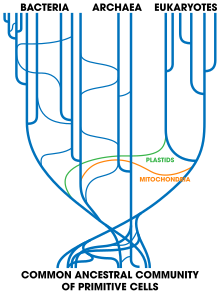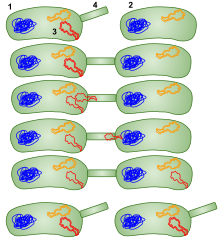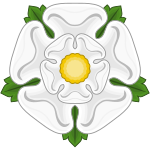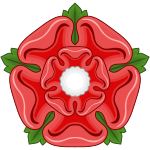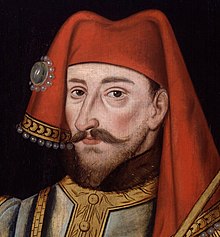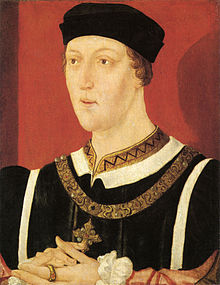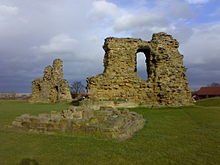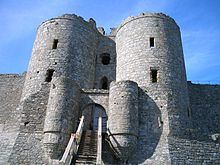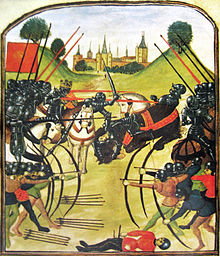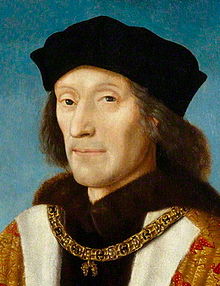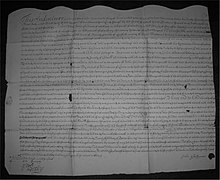From Wikipedia, the free encyclopedia
With the Duke of York's death in 1460, the claim transferred to his heir,
Edward.
After a series of Yorkist victories from January–February 1461, Edward
claimed the throne on March 4, 1461, and the last serious Lancastrian
resistance ended at decisive
Battle of Towton. Edward was thus unopposed as the first Yorkist
king of England, as
Edward IV. Resistance smoldered in the North until 1464, but the early part of his reign remained relatively peaceful.
A new phase of the wars broke out in 1469 after
The Earl of Warwick,
the most powerful noble in the country, withdrew his support for Edward
and threw it behind the Lancastrian cause. Fortunes changed many times
as the Yorkist and Lancastrian forces exchanged victories throughout
1469–1470 (and Edward was even captured for a time in 1469). When
Edward fled to Flanders in 1470,
Henry VI was re-installed as king
on 3 October 1470, but his resumption of rule was short lived, and he
was deposed again following the defeat of his forces at the
Battle of Tewkesbury,
and on 21 May 1471, Edward entered London unopposed, resumed the
throne, and probably had Henry killed that same day. With all
significant Lancastrian leaders now banished or killed, Edward ruled
unopposed until his sudden death in 1483. His son reigned for 78 days as
Edward V, but was then deposed by his uncle, who became
Richard III.
The ascension of Richard III occurred under a cloud of
controversy, and shortly after assuming the throne, the wars sparked
anew with
Buckingham's rebellion,
as many die-hard Yorkists abandoned Richard to join Lancastrians.
While the rebellions lacked much central coordination, in the chaos the
exiled
Henry Tudor, son of Henry VI's half-brother Edmund
Earl of Richmond, and the leader of the Lancastrian cause, returned to the country from exile in
Brittany at the head of an army of combined Breton and English forces. Richard avoided direct conflict with Henry until the
Battle of Bosworth Field
on 22 August 1485. After Richard III was killed and his forces
defeated at Bosworth Field, Henry assumed the throne as Henry VII and
married
Elizabeth of York, the eldest daughter and heir of Edward IV, thereby uniting the two claims. The
House of Tudor ruled the
Kingdom of England until 1603, with the death of
Elizabeth I, granddaughter of Henry VII and Elizabeth of York.
Name and symbols
The Yorkist faction used the symbol of the white rose from early
in the conflict, but the Lancastrian red rose was introduced only after
the victory of
Henry Tudor at the
Battle of Bosworth in 1485, when it was combined with the Yorkist white rose to form the
Tudor rose, which symbolised the union of the two houses; the origins of the Rose as a cognizance itself stem from
Edward I's use of "a golden rose stalked proper." Often, owing to nobles holding multiple titles, more than one badge was used:
Edward IV, for example, used both his
sun in splendour as
Earl of March, but also his father's falcon and
fetterlock as
Duke of York. Badges were not always distinct; at the
Battle of Barnet, Edward's 'sun' was very similar to the
Earl of Oxford's
Vere star, which caused fateful confusion.
Most, but not all, of the participants in the wars wore
livery badges associated with their immediate lords or patrons under the prevailing system of
bastard feudalism; the wearing of livery was by now confined to those in "continuous employ of a lord", thus excluding, for example, mercenaries. Another example: Henry Tudor's forces at Bosworth fought under the banner of a
red dragon while the Yorkist army used Richard III's
personal device of a
white boar.
Summary of events
Important locations in the Wars of the Roses
Tensions within England during the 1450s centered on the mental state of
Henry VI and on his inability to produce an heir with his wife,
Margaret of Anjou.
In the absence of a direct heir, there were two rival branches with
claims to the throne should Henry die without issue, being the
Beaufort family, led by
Edmund Beaufort, 2nd Duke of Somerset, and the
House of York, headed by
Richard of York.
By 1453, issues had come to a head: though Margaret of Anjou was
pregnant, Henry VI was descending into increasing mental instability, by
August becoming completely non-responsive and unable to govern. A
Great Council of nobles was called, and through shrewd political machinations, Richard had himself declared
Lord Protector and chief regent during the mental incapacity of Henry. In the interlude, Margaret gave birth to a healthy son and heir,
Edward of Westminster.
By 1455, Henry had regained his faculties, and open warfare came at the
First Battle of St Albans.
Several prominent Lancastrians died at the hands of the Yorkists.
Henry was again imprisoned, and Richard of York resumed his role as Lord
Protector. Although peace was temporarily restored, the Lancastrians
were inspired by Margaret of Anjou to contest York's influence, and a
deadly
feud between the two branches of the royal family ensued.
After Lancastrian revolts in the north were suppressed in 1464, Henry was captured once again and placed in the
Tower of London.
Edward fell out with his chief supporter and adviser, the Earl of
Warwick (known as the "Kingmaker"), after Edward's unpopular and
secretly conducted marriage with the widow of
a Lancastrian supporter,
Elizabeth Woodville.
Within a few years, it became clear that Edward was favouring his
wife's family and alienating a number of friends closely aligned with
Warwick as well.
Furious, Warwick tried first to supplant Edward with his younger brother
George, Duke of Clarence, establishing the alliance by marriage to his daughter,
Isabel Neville. When that plan failed, due to lack of support from
Parliament,
Warwick sailed to France with his family and made an alliance with the
former Lancastrian Queen, Margaret of Anjou, to restore Henry VI to the
throne.
This resulted in two years of rapid changes of fortune before Edward IV once again won complete victories at
Barnet (14 April 1471), where Warwick was killed, and
Tewkesbury
(4 May 1471), where the Lancastrian heir, Edward of Westminster, Prince
of Wales was killed or perhaps executed after the battle. Queen
Margaret was escorted to London as a prisoner, and Henry was murdered in
the Tower of London several days later, ending the direct Lancastrian
line of succession.
A period of comparative peace followed, ending with the unexpected death of King Edward in 1483. His surviving brother
Richard, Duke of Gloucester,
first moved to prevent the unpopular Woodville family of Edward's widow
from participating in the government during the minority of Edward's
son,
Edward V, and then seized the throne for himself, using the suspect legitimacy of Edward IV's marriage as pretext.
Origins of the conflict
Disputed succession
In the early middle ages, the succession to the crown was open to any member (
Ætheling)
of the royal family. From the 9th century, the term was used in a much
narrower context and came to refer exclusively to members of the house
of
Cerdic of Wessex, the
ruling dynasty of Wessex, most particularly the sons or brothers of the reigning king. According to historian Richard Abels "
King Alfred
transformed the very principle of royal succession. Before Alfred, any
nobleman who could claim royal descent, no matter how distant, could
strive for the throne. After him, throne-worthiness would be limited to
the sons and brothers of the reigning king."
Alfred himself succeeded to the throne in preference to the sons of
his brother the previous king, who were under age at the time. In the
reign of
Edward the Confessor,
Edgar the Ætheling received the appellation as the grandson of
Edmund Ironside, but that was at a time when for the first time in 250 years there was no living ætheling according to the strict definition.
The question of succession after
Edward III's death in 1377 is said to be the cause of the Wars of Roses. He had five surviving legitimate sons:
Edward, the Black Prince (1330–1376);
Lionel, Duke of Clarence (called 'Lionel of Antwerp' 1338–1368);
John, Duke of Lancaster (called 'John of Gaunt'; 1340–1399);
Edmund, Duke of York (called 'Edmund of Langley' 1341–1402); and
Thomas, Duke of Gloucester
(1355–1397). Although Edward III's succession seemed secure, there was a
"sudden narrowing in the direct line of descent" near the end of his
reign.
His eldest son Edward, the Black Prince, had died the year before.
Edward III was succeeded on the throne by the Black Prince's only
surviving son
Richard II, who was only 10 years old.
Richard's claim to the throne was based on the principle that the son
of an elder brother had priority in the succession over his uncles.
Since Richard was a minor, had no siblings, and had three living uncles
at the time of Edward III's death, there was considerable uncertainty
about who was next in line for the succession after Richard.
If Richard II died without legitimate offspring, his successors by
primogeniture would be the descendants of Lionel of Antwerp, Edward III's second son. Clarence's only daughter,
Philippa, 5th Countess of Ulster, married into the
Mortimer family and had a son,
Roger Mortimer, 4th Earl of March
(1374–1398), who technically had the best claim to succeed. However, a
legal decree issued by Edward III in 1376 introduced some complexity
into the question of who would ultimately take the throne. The
letters patent
he issued limited the right of succession to male heirs, which placed
his third son, John of Gaunt, ahead of Clarence's descendants because
the Mortimer line of descent passed through a daughter.
Richard II's reign was marked by increasing dissension between the King and several of the most powerful nobles. In 1399, he exiled Gaunt's son
Henry of Bolingbroke. Richard's government had become highly unpopular beyond his strongholds in
Cheshire and
Wales. Throughout his reign, Richard had repeatedly switched his choice of heir in order to keep his political enemies at bay and perhaps to reduce the chances of
deposition. Nevertheless, when Bolingbroke returned from exile in 1399, initially to reclaim his rights as
Duke of Lancaster, he took advantage of the support of most of the nobles to depose Richard and was crowned King Henry IV, establishing the
House of Lancaster on the throne.
House of Lancaster
Henry IV's claim to the throne was through his father, John of
Gaunt. At the onset of Richard II's reign, Gaunt was the official
heir presumptive,
but due to the intrigues of his turbulent rule, the succession was
unclear by the time of his deposition. Therefore, an argument could be
made that the legitimate king of England was not Henry IV, but instead
was
Edmund Mortimer, 5th Earl of March,
the son of Roger Mortimer, 4th Earl of March. However, there was little
support at the time for his counter-claim. Certainly many people
believed it to be the case. As Henry's initial popularity waned, the
Mortimer family's claim to the throne was a pretext for the major
rebellion of
Owain Glyndŵr in
Wales, and other, less successful, revolts in
Cheshire and
Northumberland. There were uprisings in support of the Mortimers' claim throughout Henry IV's reign, which lasted until 1413.
A peculiarity of Henry IV's seizure of the throne is demonstrated
in the way he announced his claim. He was vague, and he resigned
himself to mentioning that he was the rightful heir of
Henry III, who had died more than a century before, perhaps subtly implying that all English kings ever since (
Edward I,
Edward II,
Edward III and Richard II) had not been rightful monarchs. Henry IV
seems to have been exploiting a legend that Henry III's second son
Edmund "Crouchback", 1st Earl of Lancaster,
was in fact his eldest son but had been removed from succession because
he had a physical deformity, which gave origin to his nickname. Since
Henry IV was Edmund's descendant and heir through his mother Blanche of
Lancaster, he was in fact the rightful king. There is no evidence for
this legend, and Edmund's nickname did not stem from a deformity.
An important branch of the House of Lancaster was the
House of Beaufort, whose members were descended from Gaunt by his mistress,
Katherine Swynford.
Originally illegitimate, they were made legitimate by an Act of
Parliament when Gaunt and Katherine later married. However, Henry IV
excluded them from the line of succession to the throne.
Henry IV's son and successor,
Henry V, inherited a temporarily pacified nation, and his military success against France in the
Hundred Years' War
bolstered his popularity, enabling him to strengthen the Lancastrian
hold on the throne. Nevertheless, one notable conspiracy against Henry,
the
Southampton Plot, took place during his nine-year reign. This was led by
Richard, Earl of Cambridge, who attempted to place Edmund Mortimer, his brother-in-law, in the throne. Cambridge was executed for
treason in 1415, at the start of the campaign that led to the
Battle of Agincourt.
House of York
The founder of the
House of York
was Edmund of Langley, the fourth son of Edward III and the younger
brother of John of Gaunt. Their family name comes from Edmund's title
Duke of York,
which he acquired in 1385. However, the superiority of their claim is
not based on the male line, but on the female line, as descendants of
Edward III's second son Lionel of Antwerp. Edmund's second son, Richard,
Earl of Cambridge, who was executed by Henry V, had married
Anne de Mortimer, daughter of Roger Mortimer and sister of Edmund Mortimer. Anne's grandmother,
Philippa of Clarence, was the daughter of Lionel of Antwerp. The Mortimers were the most powerful
marcher family of the fourteenth century. G.M. Trevelyan has written that "the Wars of the Roses were to a large extent a quarrel between Welsh
Marcher Lords, who were also great English nobles, closely related to the English throne."
Anne de Mortimer had died in 1411. When her brother Edmund Mortimer,
5th Earl of March, who had loyally supported Henry, died childless in
1425, the title and extensive estates of the
Earldom of March and the Mortimer claim to the throne thus passed to Anne's descendants.
Richard of York, the son of Cambridge and Anne Mortimer, was four years old at the time of his father's execution. Although Cambridge was
attainted, Henry V later allowed Richard to inherit the title and lands of Cambridge's elder brother
Edward, Duke of York,
who had died fighting alongside Henry at Agincourt and had no issue.
Henry, who had three younger brothers and was himself in his prime and
recently married to the French princess,
Catherine of Valois, had no doubt that the Lancastrian right to the crown was secure.
Henry's premature death in 1422, at the age of 36, led to his only son
Henry VI
coming to the throne as an infant and the country being ruled by a
divided Council of regency. Henry V's younger brothers produced no
surviving legitimate issue, leaving only distant cousins (the Beauforts)
as alternative Lancaster heirs. As Richard of York grew into maturity
and questions were raised over Henry VI's fitness to rule, Richard's
claim to the throne thus became more significant. The revenue from the
York and March estates also made him the wealthiest magnate in the land.
Henry VI
From early childhood,
Henry VI was surrounded by quarrelsome councillors and advisors. His younger surviving paternal uncle,
Humphrey, Duke of Gloucester, sought to be named
Lord Protector and deliberately courted the popularity of the common people for his own ends but was opposed by his half-uncle
Cardinal Henry Beaufort. On several occasions, Beaufort called on
John, Duke of Bedford, Humphrey's older brother, to return from his post as Henry VI's
regent in
France, either to mediate or to defend him against Humphrey's accusations of treason.
Henry VI's coming of age in 1437 brought no end to the noblemen's
scheming, as his weak personality made him prone to being swayed and
influenced by select
courtiers, especially those whom he deemed his
favourites. Some time after, Cardinal Beaufort withdrew from public affairs, partly due to old age and partly because
William de la Pole, 1st Duke of Suffolk, rose to become the dominant personality at court.
Suffolk and the Beauforts were widely held to be enriching themselves
through their influence on Henry, and were blamed for mismanaging the
government and poorly executing the continuing
Hundred Years' War with France. Under Henry VI, all the land in France won by
Henry V and even the provinces of
Guienne and
Gascony, which had been held since the reign of Henry II three centuries previously, were lost.
Opposition to Suffolk and Beaufort was led by Humphrey of Gloucester, and
Richard of York.
Humphrey felt that the lifetime efforts of his brothers, of himself,
and of many Englishmen in the war against France were being wasted as
the French territories slipped from English hands, especially since
Suffolk and his supporters were trying to make large diplomatic and
territorial concessions to the French in a desperate attempt for peace.
In this, Gloucester enjoyed little influence, as Henry VI tended to
favour Suffolk and Beaufort's faction at court due to its less
hawkish
and more conciliatory inclinations. The Duke of York, Bedford's
successor in France, and at times also described as a skeptic of the
peace policy, became entangled in this dispute as Suffolk and the
Beauforts were frequently granted large money and land grants from the
king, as well as important government and military positions,
redirecting much needed resources away from York's campaigns in France.
Suffolk eventually succeeded in having Humphrey of Gloucester
arrested for treason. Humphrey died while awaiting trial in prison at
Bury St Edmunds
in 1447. Some authorities date the start of the War of the Roses from
the death of Humphrey. At the same time, Richard of York was stripped of
the prestigious military command in France and sent to govern the
relatively distant
Ireland,
whereby he could not interfere in the proceedings of the court.
However, with severe reverses in France, Suffolk was stripped of office
and was murdered on his way to exile.
Edmund Beaufort, 2nd Duke of Somerset
(Cardinal Beaufort's nephew), succeeded him as leader of the party
seeking peace with France. The Duke of York meanwhile represented those
who wished to prosecute the war more vigorously, and criticised the
court, and Somerset in particular, for starving him of funds and men
during his campaigns in France.
In all these quarrels, Henry VI had taken little part. He was
seen as a weak, ineffectual king. In addition, he displayed several
symptoms of mental illness that he may have inherited from his maternal grandfather,
Charles VI of France. By 1450 many considered Henry incapable of carrying out the duties and responsibilities of a king.
In 1450, there was a violent popular revolt in Kent,
Jack Cade's Rebellion, which is often seen as the prelude to the Wars of the Roses. The rebel manifesto,
The Complaint of the Poor Commons of Kent
written under Cade's leadership, accused the crown of extortion,
perversion of justice, and election fraud. The rebels occupied parts of
London, and executed
James Fiennes, 1st Baron Saye and Sele, the unpopular
Lord High Treasurer, after a hasty trial. After some of them fell to looting, they were driven out of
London by the citizens. They dispersed after they were supposedly pardoned but several, including Cade, were later executed.
After the rebellion the rebels' grievances formed the basis of Richard
of York's opposition to a royal government from which he felt excluded.
Two years later, in 1452, Richard of York returned to England
from his new post as Lieutenant of Ireland and marched on London,
demanding Somerset's removal and reform of the government. At this
stage, few of the nobles supported such drastic action, and York was
forced to submit to superior force at
Blackheath. He was imprisoned for much of 1452 and 1453 but was released after swearing not to take arms against the court.
The increasing discord at court was mirrored in the country as a
whole, where noble families engaged in private feuds and showed
increasing disrespect for the royal authority and for the courts of law.
In many cases feuds were fought between old-established families, and
formerly minor nobility raised in power and influence by Henry IV in the
aftermath of the rebellions against him. The
quarrel
between the Percys—long the Earls of Northumberland—and the
comparatively upstart Nevilles was the best-known of these private wars
and followed this pattern, as did the
Bonville–Courtenay feud in
Cornwall and
Devon.
A factor in these feuds was the presence of large numbers of soldiers
discharged from the English armies that had been defeated in France.
Nobles engaged many of these to mount raids, or to pack courts of
justice with their supporters, intimidating suitors, witnesses and
judges.
This growing civil discontent, the abundance of feuding nobles
with private armies, and corruption in Henry VI's court formed a
political climate ripe for civil war. With the king so easily
manipulated, power rested with those closest to him at court, in other
words, Somerset and the Lancastrian faction. Richard and the Yorkist
faction, who tended to be physically placed further away from the seat
of power, found their power slowly being stripped away. Royal power and
finances also started to slip, as Henry was persuaded to grant many
royal lands and estates to the Lancastrians, thereby losing their
revenue.
In 1453, Henry suffered the first of several bouts of complete
mental collapse, during which he failed even to recognise his new-born
son,
Edward of Westminster. On 22 March 1454, Cardinal
John Kemp, the
Chancellor, died. Henry was incapable of nominating a successor.
To ensure that the country could be governed, a Council of Regency was
set up, headed by the Duke of York, who still remained popular with the
people, as
Lord Protector.
York soon asserted his power with ever-greater boldness (although there
is no proof that he had aspirations to the throne at this early stage).
He imprisoned Somerset and backed his Neville allies (his
brother-in-law,
the Earl of Salisbury, and Salisbury's son,
the Earl of Warwick), in their continuing feud with the
Earl of Northumberland, a powerful supporter of Henry.
Henry recovered in 1455 and once again fell under the influence
of those closest to him at court. Directed by Henry's queen, the
powerful and aggressive
Margaret of Anjou, who emerged as the
de facto
leader of the Lancastrians, Richard was forced out of court. Margaret
built up an alliance against Richard and conspired with other nobles to
reduce his influence. An increasingly thwarted Richard (who feared
arrest for treason) finally resorted to armed hostilities in 1455.
Start of the war
The Lancastrian siege of London in 1471 is attacked by a Yorkist sally.
Richard, Duke of York, led a small force toward London and was met by Henry's forces at
St Albans, north of London, on 22 May 1455. The relatively small
First Battle of St Albans
was the first open conflict of the civil war. Richard's aim was
ostensibly to remove "poor advisors" from King Henry's side. The result
was a Lancastrian defeat. Several prominent Lancastrian leaders,
including Somerset and Northumberland, were killed. After the battle,
the Yorkists found Henry hiding in a local
tanner's shop,
abandoned by his advisers and servants, apparently having suffered
another bout of mental illness. (He had also been slightly wounded in
the neck by an arrow.)
York and his allies regained their position of influence. With the king
indisposed, York was again appointed Protector, and Margaret was
shunted aside, charged with the king's care.
For a while, both sides seemed shocked that an actual battle had
been fought and did their best to reconcile their differences, but the
problems that caused conflict soon re-emerged, particularly the issue of
whether the Duke of York, or Henry and Margaret's infant son, Edward,
would succeed to the throne. Margaret refused to accept any solution
that would disinherit her son, and it became clear that she would only
tolerate the situation for as long as the Duke of York and his allies
retained the military ascendancy.
Henry recovered and in February 1456 he relieved York of his office of Protector. In the autumn of that year, Henry went on
royal progress in
the Midlands,
where the king and queen were popular. Margaret did not allow him to
return to London where the merchants were angry at the decline in trade
and the widespread disorder. The king's court was set up at
Coventry. By then, the new
Duke of Somerset
was emerging as a favourite of the royal court. Margaret persuaded
Henry to revoke the appointments York had made as Protector, while York
was made to return to his post as lieutenant in Ireland.
Disorder in the capital and the
north of England (where fighting between the Nevilles and Percys had resumed )
and piracy by French fleets on the south coast were growing, but the
king and queen remained intent on protecting their own positions, with
the queen introducing
conscription
for the first time in England. Meanwhile, York's ally, Warwick (later
dubbed "The Kingmaker"), was growing in popularity in London as the
champion of the merchants; as
Captain of Calais he had fought piracy in
the Channel.
In the spring of 1458,
Thomas Bourchier, the
Archbishop of Canterbury,
attempted to arrange a reconciliation. The lords had gathered in London
for a Grand Council and the city was full of armed retainers. The
Archbishop negotiated complex settlements to resolve the blood-feuds
that had persisted since the Battle of St. Albans. Then, on
Lady Day (25 March), the King led a "
love day" procession to
St. Paul's Cathedral, with Lancastrian and Yorkist nobles following him, hand in hand. No sooner had the procession and the Council dispersed than plotting resumed.
Act of Accord
The next outbreak of fighting was prompted by Warwick's high-handed actions as
Captain of Calais. He led his ships in attacks on neutral
Hanseatic League
and Spanish ships in the Channel on flimsy grounds of sovereignty. He
was summoned to London to face enquiries, but he claimed that attempts
had been made on his life, and returned to Calais. York, Salisbury and
Warwick were summoned to a royal council at Coventry, but they refused,
fearing arrest when they were isolated from their own supporters.
York summoned the Nevilles to join him at his stronghold at
Ludlow Castle in the Welsh Marches. On 23 September 1459, at the
Battle of Blore Heath in Staffordshire, a Lancastrian army failed to prevent Salisbury from marching from
Middleham Castle in Yorkshire to Ludlow. Shortly afterwards the combined Yorkist armies confronted the much larger Lancastrian force at the
Battle of Ludford Bridge. Warwick's contingent from the garrison of
Calais under
Andrew Trollope defected to the Lancastrians, and the Yorkist leaders fled. York returned to Ireland, and his eldest son,
Edward, Earl of March, Salisbury and Warwick fled to Calais.
The Lancastrians were back in total control. York and his supporters were
attainted at the
Parliament of Devils
as traitors. Somerset was appointed Governor of Calais and was
dispatched to take over the vital fortress on the French coast, but his
attempts to evict Warwick were easily repulsed. Warwick and his
supporters even began to launch raids on the English coast from Calais,
adding to the sense of chaos and disorder. Being attainted, only by a
successful invasion could the Yorkists recover their lands and titles.
Warwick travelled to Ireland to concert plans with York, evading the
royal ships commanded by the
Duke of Exeter.
In late June 1460, Warwick, Salisbury and Edward of March crossed the Channel and rapidly established themselves in
Kent
and London, where they enjoyed wide support. Backed by a papal emissary
who had taken their side, they marched north. King Henry led an army
south to meet them while Margaret remained in the north with Prince
Edward. At the
Battle of Northampton
on 10 July, the Yorkist army under Warwick defeated the Lancastrians,
aided by treachery in the king's ranks. For the second time in the war,
King Henry was found by the Yorkists in a tent, abandoned by his
retinue, having apparently suffered another breakdown. With the king in
their possession, the Yorkists returned to London.
In the light of this military success, Richard of York moved to
press his claim to the throne based on the illegitimacy of the
Lancastrian line. Landing in north
Wales, he and his wife
Cecily entered London with all the ceremony usually reserved for a monarch.
Parliament
was assembled, and when York entered he made straight for the throne,
which he may have been expecting the Lords to encourage him to take for
himself as they had acclaimed Henry IV in 1399. Instead, there was
stunned silence. York announced his claim to the throne, but the Lords,
even Warwick and Salisbury, were shocked by his presumption; they had no
desire at this stage to overthrow King Henry. Their ambition was still
limited to the removal of his councillors.
The next day, York produced detailed
genealogies to support his claim based on his descent from
Lionel of Antwerp, Duke of Clarence. York's claim was through a daughter of a second son, Henry's through the son of a third son. The judges felt that
Common law
principles could not determine who had priority in the royal
succession, and declared the matter "above the law and passed ther
lernyng."
Parliament agreed to consider the matter and accepted that York's claim
was better, but by a majority of five, they voted that Henry VI should
remain as king. A compromise was struck in October 1460 with the
Act of Accord,
which recognised York as Henry's successor, disinheriting Henry's
six-year-old son, Edward. York accepted this compromise as the best
offer. It gave him much of what he wanted, particularly since he was
also made Protector of the Realm and was able to govern in Henry's name.
Death of Richard, Duke of York
Queen Margaret and her son had fled to north
Wales, parts of which were still in Lancastrian hands. They later travelled by sea to
Scotland to negotiate for Scottish assistance.
Mary of Gueldres, Queen Consort to
James II of Scotland, agreed to give Margaret an army on condition that she cede the town of
Berwick
to Scotland and Mary's daughter be betrothed to Prince Edward. Margaret
agreed, although she had no funds to pay her army and could only
promise booty from the riches of southern England, as long as no looting
took place north of the
River Trent.
The Duke of York left London later that year with the Earl of
Salisbury to consolidate his position in the north against the
Lancastrians who were reported to be massing near the city of
York. He took up a defensive position at
Sandal Castle near
Wakefield
over Christmas 1460. Then on 30 December, his forces left the castle
and attacked the Lancastrians in the open, although outnumbered. The
ensuing
Battle of Wakefield
was a complete Lancastrian victory. Richard of York was slain in the
battle, and both Salisbury and York's 17-year-old second son,
Edmund, Earl of Rutland, were captured and executed. Margaret ordered the heads of all three placed on the gates of York.
Edward's claim to the throne
The Act of Accord and the events of Wakefield left the 18-year-old
Edward, Earl of March, York's eldest son, as Duke of York and heir to
his claim to the throne. With an army from the pro-Yorkist Marches (the
border area between England and Wales), he met
Jasper Tudor's Lancastrian army arriving from Wales, and he defeated them soundly at the
Battle of Mortimer's Cross in Herefordshire. He inspired his men with a "vision" of three suns at dawn (a phenomenon known as "
parhelion"), telling them that it was a portent of victory and represented the three surviving York sons; himself,
George and
Richard. This led to Edward's later adoption of the sign of the
sunne in splendour as his
personal device.
Margaret's army was moving south, supporting itself by looting as
it passed through the prosperous south of England. In London, Warwick
used this as propaganda to reinforce Yorkist support throughout the
south – the town of
Coventry
switched allegiance to the Yorkists. Warwick's army established
fortified positions north of the town of St Albans to block the main
road from the north but was outmanoeuvred by Margaret's army, which
swerved to the west and then attacked Warwick's positions from behind.
At the
Second Battle of St Albans,
the Lancastrians won another big victory. As the Yorkist forces fled
they left behind King Henry, who was found unharmed, sitting quietly
beneath a tree.
Henry knighted thirty Lancastrian soldiers immediately after the
battle. In an illustration of the increasing bitterness of the war,
Queen Margaret instructed her seven-year-old son Edward of Westminster
to determine the manner of execution of the Yorkist knights who had been
charged with keeping Henry safe and had stayed at his side throughout
the battle.
As the Lancastrian army advanced southwards, a wave of dread
swept London, where rumours were rife about savage northerners intent on
plundering the city. The people of London shut the city gates and
refused to supply food to the queen's army, which was looting the
surrounding counties of
Hertfordshire and
Middlesex.
Yorkist triumph

Edward of March, having joined with Warwick's surviving forces,
advanced towards London from the west at the same time that the queen
retreated northwards to
Dunstable;
as a result, Edward and Warwick were able to enter London with their
army. They found considerable support there, as the city was largely
Yorkist-supporting. It was clear that Edward was no longer simply trying
to free the king from bad councillors, but that his goal was to take
the crown.
Thomas Kempe, the
Bishop of London,
asked the people of London their opinion and they replied with shouts
of "King Edward". The request was quickly approved by Parliament, and
Edward was unofficially appointed king in an impromptu ceremony at
Westminster Abbey; Edward vowed that he would not have a formal
coronation
until Henry VI and his wife were removed from the scene. Edward claimed
Henry had forfeited his right to the crown by allowing his queen to
take up arms against his rightful heirs under the Act of Accord.
Parliament had already accepted that Edward's victory was simply a
restoration of the rightful heir to the throne.
Edward and Warwick marched north, gathering a large army as they
went, and met an equally impressive Lancastrian army at Towton. The
Battle of Towton,
near York, was the biggest battle of the Wars of the Roses. Both sides
agreed beforehand that the issue would be settled that day, with no
quarter asked or given. An estimated 40,000–80,000 men took part, with
over 20,000 men being killed during (and after) the battle, an enormous
number for the time and the greatest recorded single day's loss of life
on English soil. Edward and his army won a decisive victory, and the
Lancastrians were routed, with most of their leaders slain. Henry and
Margaret, who were waiting in York with their son Edward, fled north
when they heard the outcome. Many of the surviving Lancastrian nobles
switched allegiance to King Edward, and those who did not were driven
back to the northern border areas and a few castles in Wales. Edward
advanced to take York, where he replaced the rotting heads of his
father, his brother, and Salisbury with those of defeated Lancastrian
lords such as the notorious
John Clifford, 9th Baron de Clifford of Skipton-Craven, who was blamed for the execution of Edward's brother Edmund, Earl of Rutland, after the
Battle of Wakefield.
Edward IV
The official coronation of Edward IV took place in June 1461 in
London, where he received a rapturous welcome from his supporters.
After the Battle of Towton, Henry VI and Margaret had fled to Scotland, where they stayed with the court of
James III and followed through on their promise to cede Berwick to Scotland. Later in the year, they mounted an attack on
Carlisle,
but, lacking money, they were easily repulsed by Edward's men, who were
rooting out the remaining Lancastrian forces in the northern counties.
Several castles under Lancastrian commanders held out for years:
Dunstanburgh,
Alnwick (the Percy family seat), and
Bamburgh were some of the last to fall.
There was also some fighting in Ireland. At the
Battle of Piltown
in 1462, the Yorkish supporter Thomas FitzGerald, 7th Earl of Desmond,
defeated the Lancastrian Butlers of Kilkenny. The Butlers suffered more
than 400 casualties. Local folklore claims that the battle was so
violent that the local river ran red with blood, hence the names Pill
River and Piltown (
Baile an Phuill, meaning "Town of the blood").
There were Lancastrian revolts in the north of England in 1464. Several Lancastrian nobles, including the third
Duke of Somerset, who had apparently been reconciled to Edward, readily led the rebellion. The revolt was put down by Warwick's brother,
John Neville. A small Lancastrian army was destroyed at the
Battle of Hedgeley Moor
on 25 April, but because Neville was escorting Scottish commissioners
for a treaty to York, he could not immediately follow up this victory.
Then on 15 May, he routed Somerset's army at the
Battle of Hexham. Somerset was captured and executed.
The deposed King Henry was later captured for the third time at
Clitheroe in Lancashire in 1465. He was taken to London and held prisoner at the
Tower of London,
where, for the time being, he was reasonably well treated. About the
same time, once England under Edward IV and Scotland had come to terms,
Margaret and her son were forced to leave Scotland and sail to France,
where they maintained an impoverished court in exile for several years. The last remaining Lancastrian stronghold was
Harlech Castle in Wales, which surrendered in 1468 after a seven-year-long siege.
Warwick's rebellion and the death of Henry VI
The powerful Earl of Warwick ("the Kingmaker") had meanwhile become
the greatest landowner in England. Already a great magnate through his
wife's property, he had also inherited his father's estates and had been
granted much forfeited Lancastrian property. He also held many of the
offices of state. He was convinced of the need for an alliance with
France and had been negotiating a match between Edward and a French
bride. However, Edward had married
Elizabeth Woodville, the widow of a Lancastrian knight, in secret in 1464. He later announced the news of his marriage as
fait accompli, to Warwick's considerable embarrassment.
This embarrassment turned to bitterness when the Woodvilles came
to be favoured over the Nevilles at court. Many of Queen Elizabeth's
relatives were married into noble families and others were granted
peerages or royal offices. Other factors compounded Warwick's
disillusionment: Edward's preference for an alliance with
Burgundy rather than France and reluctance to allow his brothers
George, Duke of Clarence and
Richard, Duke of Gloucester, to marry Warwick's daughters
Isabel and
Anne.
Furthermore, Edward's general popularity was on the wane in this period
with higher taxes and persistent disruptions of law and order.
By 1469, Warwick had formed an alliance with Edward's jealous and
treacherous brother George, who married Isabel Neville in defiance of
Edward's wishes in Calais. They raised an army that defeated the king's
forces at the
Battle of Edgecote Moor. Edward was captured at
Olney, Buckinghamshire, and imprisoned at
Middleham Castle in Yorkshire. (Warwick briefly had
two Kings of England in his custody.) Warwick had the queen's father,
Richard Woodville, 1st Earl Rivers, and her brother
John executed. However, he made no immediate move to have Edward declared illegitimate and place George on the throne. The country was in turmoil, with nobles once again settling scores with private armies (in episodes such as the
Battle of Nibley Green), and Lancastrians being encouraged to rebel. Few of the nobles were prepared to support Warwick's seizure of power. Edward was escorted to London by Warwick's brother
George Neville, the
Archbishop of York, where he and Warwick were reconciled, to outward appearances.
When further rebellions broke out in
Lincolnshire, Edward easily suppressed them at the
Battle of Losecoat Field.
From the testimony of the captured leaders, he declared that Warwick
and George, Duke of Clarence, had instigated them. They were declared
traitors and forced to flee to France, where Margaret of Anjou was
already in exile.
Louis XI of France, who wished to forestall a hostile alliance between Edward and Edward's brother-in-law
Charles the Bold,
Duke of Burgundy,
suggested the idea of an alliance between Warwick and Margaret. Neither
of those two formerly mortal enemies entertained the notion at first,
but eventually they were brought round to realise the potential
benefits. However, both were undoubtedly hoping for different outcomes:
Warwick for a puppet king in the form of Henry VI or his young son;
Margaret to be able to reclaim her family's realm. In any case, a
marriage was arranged between Warwick's daughter Anne and Margaret's son
Edward of Westminster, and Warwick invaded England in the autumn of
1470.
Edward IV had already marched north to suppress another uprising in
Yorkshire. Warwick, with help from a fleet under his nephew, the
Bastard of Fauconberg,
landed at Dartmouth and rapidly secured support from the southern
counties and ports. He occupied London in October and paraded Henry VI
through the streets as the restored king. Warwick's brother John
Neville, who had recently received the empty title Marquess of Montagu
and who led large armies in the Scottish marches, suddenly defected to
Warwick. Edward was unprepared for this event and had to order his army
to scatter. He and Richard, Duke of Gloucester, fled from Doncaster to
the coast and thence to
Holland and exile in Burgundy. They were proclaimed traitors, and many exiled Lancastrians returned to reclaim their estates.
Warwick's success was short-lived, however. He over-reached
himself with his plan to invade Burgundy in alliance with the King of
France, tempted by King Louis' promise of territory in the Netherlands
as a reward. This led Edward's brother-in-law, Charles of Burgundy, to
provide funds and troops to Edward to enable him to launch an invasion
of England in 1471. Edward landed with a small force at
Ravenspur
on the Yorkshire coast. Initially claiming to support Henry and to be
seeking only to have his title of Duke of York restored, he soon gained
the city of York and rallied several supporters. His brother George
turned traitor again, abandoning Warwick. Having outmaneuvered Warwick
and Montagu, Edward captured London. His army then met Warwick's at the
Battle of Barnet.
The battle was fought in thick fog, and some of Warwick's men attacked
each other by mistake. It was believed by all that they had been
betrayed, and Warwick's army fled. Warwick was cut down trying to reach
his horse. Montagu was also killed in the battle.
Margaret and her son Edward had landed in the
West Country
only a few days before the Battle of Barnet. Rather than return to
France, Margaret sought to join the Lancastrian supporters in Wales and
marched to cross the
Severn but was thwarted when the city of
Gloucester refused her passage across the river. Her army, commanded by the fourth successive
Duke of Somerset, was brought to battle and destroyed at the
Battle of Tewkesbury.
Her son Prince Edward, the Lancastrian heir to the throne, was killed.
With no heirs to succeed him, Henry VI was murdered shortly afterwards,
on 21 May 1471, to strengthen the Yorkist hold on the throne.
Richard III
The restoration of Edward IV in 1471 is sometimes seen as marking the
end of the Wars of the Roses proper. Peace was restored for the
remainder of Edward's reign. His youngest brother,
Richard, Duke of Gloucester, and Edward's lifelong companion and supporter,
William Hastings, were generously rewarded for their loyalty, becoming effectively governors of the north and midlands respectively. George of Clarence became increasingly estranged from Edward, and was executed in 1478 for association with convicted traitors.
When Edward died suddenly in 1483, political and dynastic turmoil
erupted again. Many of the nobles still resented the influence of the
queen's Woodville relatives (her brother,
Anthony Woodville, 2nd Earl Rivers and her son by her first marriage,
Thomas Grey, 1st Marquess of Dorset), and regarded them as power-hungry upstarts ('
parvenus'). At the time of Edward's premature death, his heir,
Edward V, was only 12 years old and had been brought up under the stewardship of Earl Rivers at
Ludlow Castle.
On his deathbed, Edward had named his surviving brother Richard
of Gloucester as Protector of England. Richard had been in the north
when Edward died. Hastings, who also held the office of
Lord Chamberlain, sent word to him to bring a strong force to London to counter any force the Woodvilles might muster. The
Duke of Buckingham also declared his support for Richard.
Richard and Buckingham overtook Earl Rivers, who was escorting the young Edward V to London, at
Stony Stratford
in Buckinghamshire on 29 April. Although they dined with Rivers
amicably, they took him prisoner the next day, and declared to Edward
that they had done so to forestall a conspiracy by the Woodvilles
against his life. Rivers and his nephew
Richard Grey were sent to
Pontefract Castle in Yorkshire and executed there at the end of June.
Edward entered London in the custody of Richard on 4 May, and was
lodged in the Tower of London. Elizabeth Woodville had already gone
hastily into sanctuary at Westminster with her remaining children,
although preparations were being made for Edward V to be crowned on 22
June, at which point Richard's authority as Protector would end. On 13
June, Richard held a full meeting of the Council, at which he accused
Hastings and others of conspiracy against him. Hastings was executed
without trial later in the day.
Thomas Bourchier, the
Archbishop of Canterbury, then persuaded Elizabeth Woodville to allow her younger son, the 9-year-old
Richard, Duke of York, to join Edward in the Tower. Having secured the boys,
Robert Stillington,
Bishop of Bath and Wells
then alleged that Edward IV's marriage to Elizabeth Woodville had been
illegal and that the two boys were therefore illegitimate. Richard then
claimed the crown as
King Richard III. The two imprisoned boys, known as the "
Princes in the Tower", disappeared and are assumed to have been murdered. There was never a trial or judicial inquest on the matter.
Perkin Warbeck claimed he was the younger of the Princes from 1490 and was recognised as such by Richard's sister, the
Duchess of Burgundy.
Having been crowned in a lavish ceremony on 6 July, Richard then
proceeded on a tour of the Midlands and the north of England, dispensing
generous bounties and charters and naming his own son as the Prince of
Wales.
Buckingham's revolt
Opposition to Richard's rule had already begun in the south when, on
18 October, the Duke of Buckingham (who had been instrumental in placing
Richard on the throne and who himself had a distant claim to the crown)
led a revolt aimed at installing the Lancastrian
Henry Tudor.
It has been argued that his supporting Tudor rather than either Edward V
or his younger brother, showed Buckingham was aware that both were
already dead.
The Lancastrian claim to the throne had descended to Henry Tudor on the death of Henry VI and his son in 1471. Henry's father,
Edmund Tudor, 1st Earl of Richmond, had been a half-brother of Henry VI, but Henry's claim to royalty was through his mother,
Margaret Beaufort. She was descended from
John Beaufort, who was a son of
John of Gaunt
and thus a grandson of Edward III. John Beaufort had been illegitimate
at birth, though later legitimised by the marriage of his parents. It
had supposedly been a condition of the legitimation that the Beaufort
descendants forfeited their rights to the crown. Henry had spent much of
his childhood under siege in Harlech Castle or in exile in
Brittany.
After 1471, Edward IV had preferred to belittle Henry's pretensions to
the crown, and made only sporadic attempts to secure him. However his
mother, Margaret Beaufort, had been twice remarried, first to
Buckingham's uncle, and then to
Thomas, Lord Stanley, one of Edward's principal officers, and continually promoted her son's rights.
Buckingham's rebellion failed. Some of his supporters in the
south rose up prematurely, thus allowing Richard's Lieutenant in the
South, the
Duke of Norfolk, to prevent many rebels from joining forces. Buckingham himself raised a force at
Brecon in
mid-Wales. He was prevented from crossing the
River Severn
to join other rebels in the south of England by storms and floods,
which also prevented Henry Tudor landing in the West Country.
Buckingham's starving forces deserted and he was betrayed and executed.
The failure of Buckingham's revolt was clearly not the end of the
plots against Richard, who could never again feel secure, and who also
suffered the loss of his
wife and eleven-year-old
son, putting the future of the Yorkist dynasty in doubt.
Henry VII
Many of Buckingham's defeated supporters and other disaffected nobles
fled to join Henry Tudor in exile. Richard made an attempt to bribe the
Duke of Brittany's chief Minister
Pierre Landais to betray Henry, but Henry was warned and escaped to France, where he was again given sanctuary and aid.
Confident that many magnates and even many of Richard's officers would join him, Henry set sail from
Harfleur on 1 August 1485, with a force of exiles and French mercenaries. With fair winds, he landed in
Pembrokeshire
six days later and the officers Richard had appointed in Wales either
joined Henry or stood aside. Henry gathered supporters on his march
through Wales and the Welsh Marches and defeated Richard at the
Battle of Bosworth Field. Richard was slain during the battle, supposedly by the major Welsh landowner
Rhys ap Thomas with a blow to the head from his
poleaxe. Rhys was knighted three days later by Henry VII.
Henry, having been acclaimed King Henry VII, strengthened his position by marrying
Elizabeth of York,
daughter of Edward IV and the best surviving Yorkist claimant,
reuniting the two royal houses. Henry merged the rival symbols of the
red rose of Lancaster and the white rose of York into the new emblem of
the red and white
Tudor Rose. Henry later shored up his position by executing a number of other claimants, a policy his son
Henry VIII continued.
Many historians consider the accession of Henry VII to mark the
end of the Wars of the Roses. Others argue that they continued to the
end of the fifteenth century, as there were several plots to overthrow
Henry and restore Yorkist claimants. Only two years after the Battle of
Bosworth, Yorkists rebelled, led by
John de la Pole, Earl of Lincoln,
who had been named by Richard III as his heir but had been reconciled
with Henry after Bosworth. The conspirators produced a pretender, a boy
named
Lambert Simnel, who resembled the young
Edward, Earl of Warwick
(son of George of Clarence), the best surviving male claimant of the
House of York. The imposture was shaky, because the young earl was still
alive and in King Henry's custody and was paraded through London to
expose the impersonation. At the
Battle of Stoke Field,
Henry defeated Lincoln's army. Lincoln died in the battle. Simnel was
pardoned for his part in the rebellion and was sent to work in the royal
kitchens.
Henry's throne was challenged again in 1491, with the appearance of the pretender
Perkin Warbeck,
who claimed he was Richard, Duke of York (the younger of the two
Princes in the Tower). Warbeck made several attempts to incite revolts,
with support at various times from the court of Burgundy and
James IV of Scotland. He was captured after the failed
Second Cornish uprising of 1497
and killed in 1499, after attempting to escape from prison. Warwick was
also executed, rendering the male-line of the House of York (and by
extension the whole Plantagenet dynasty) extinct.
During the reign of Henry VII's son Henry VIII, the possibility
of a Yorkist challenge to the throne remained until as late as 1525, in
the persons of
Edward Stafford, 3rd Duke of Buckingham,
Edmund de la Pole, 3rd Duke of Suffolk and his brother
Richard de la Pole,
all of whom had blood ties to the Yorkist dynasty but were excluded by
the pro-Woodville Tudor settlement. To an extent, England's
break with Rome
was prompted by Henry's fears of a disputed succession, should he leave
only a female heir to the throne or an infant who would be as
vulnerable as Henry VI had been to antagonistic or rapacious regents.
Aftermath
Historians
debate the extent of impact the wars had on medieval English life. The
classical view is that the many casualties among the
nobility continued the changes in feudal English society caused by the effects of the
Black Death. These included a weakening of the
feudal power
of the nobles and an increase in the power of the merchant classes, and
the growth of a centralised monarchy under the Tudors. The wars
heralded the end of the medieval period in England and the movement
towards the
Renaissance.
After the wars the large standing baronial armies that had helped fuel
the conflict were suppressed. Henry VII, wary of any further fighting,
kept the barons on a very tight leash, removing their right to raise,
arm and supply armies of retainers so that they could not make war on
each other or the king. The military power of individual barons
declined, and the Tudor court became a place where baronial squabbles
were decided with the influence of the monarch.
Revisionists, such as the Oxford historian
K. B. McFarlane, suggest that the effects of the conflicts have been greatly exaggerated and that there were no wars of the roses. Many places were unaffected by the wars, particularly in the eastern part of England, such as
East Anglia.
It has also been suggested that the traumatic impact of the wars was
exaggerated by Henry VII, to magnify his achievement in quelling them
and bringing peace. The effect of the wars on the merchant and labouring
classes was far less than in the long drawn-out wars of siege and
pillage in Europe, which were carried out by mercenaries who profited
from long wars. Although there were some lengthy sieges, such as those
of
Harlech Castle and
Bamburgh Castle,
these were in comparatively remote and less populous regions. In the
populated areas, both factions had much to lose by the ruin of the
country and sought quick resolution of the conflict by
pitched battle. Philippe de Commines observed in 1470:
The realm of England enjoys one favour above all other
realms, that neither the countryside nor the people are destroyed, nor
are buildings burnt or demolished. Misfortune falls on soldiers and
nobles in particular...
Exceptions to this claimed general rule were the Lancastrian looting of
Ludlow
after the largely bloodless Yorkist defeat at Ludford Bridge in 1459,
and the widespread pillaging carried out by Queen Margaret's unpaid army
as it advanced south in early 1461. Both events inspired widespread
opposition to the Queen, and support for the Yorkists.
Many areas did little or nothing to change their city defences,
perhaps an indication that they were left untouched by the wars. City
walls were either left in their ruinous state or only partially rebuilt.
In the case of London, the city was able to avoid being devastated by
convincing the York and Lancaster armies to stay out after the inability
to recreate the defensive city walls.
Few noble houses were extinguished during the wars; in the period
from 1425 to 1449, before the outbreak of the wars, there were as many
extinctions of noble lines from natural causes (25) as occurred during
the fighting (24) from 1450 to 1474.
The most ambitious nobles died and by the later period of the wars,
fewer nobles were prepared to risk their lives and titles in an
uncertain struggle.
The kings of France and Scotland and the dukes of Burgundy played
the two factions off against each other, pledging military and
financial aid and offering asylum to defeated nobles and pretenders, to
prevent a strong and unified England from making war on them.
Armies and warfare
Following defeat in the
Hundred Years' War,
English landowners complained vociferously about the financial losses
resulting from the loss of their continental holdings; this is often
considered a contributory cause of the Wars of the Roses. The wars were fought largely by the
landed aristocracy and armies of feudal retainers, with some mercenaries.
At the end of the Hundred Years' War large numbers of unemployed
soldiery returned to England seeking employment in the growing armies of
local nobility. England drifted toward misrule and violence under the
weak governance as local noble families like the
Nevilles and
Percies increasingly relied on their feudal retainers to settle disputes. It became common practice for landowners to bind their
mesnie knights to their service with annual payments.
Half of an indenture contract, the randomly cut (or indented) edge proves a match to the counterpart document
Edward III had developed the contract system where the monarch entered into formal written contracts called
indenture
with experienced captains who were contractually obliged to provide an
agreed upon number of men, at established rates for a given period.
Frequently the landed nobility acted the principal or main contractor.
Knights, men at arms and archers were often sub-contracted. A lord could find men amongst his tenantry who included landless men and others who would crave the security of
maintenance and livery. Skilled archers could command as high a wage as knights. As baronial armies grew in size, the rule of law was weakened.
Support for each house largely depended upon dynastic factors,
such as blood relationships, marriages within the nobility and the
grants or confiscations of feudal titles and lands. Given the
conflicting loyalties of blood, marriage and ambition, it was not
uncommon for nobles to switch sides; several battles (such as
Northampton and
Bosworth) were decided by treachery. The armies consisted of nobles' contingents of men-at-arms, with companies of archers and foot-soldiers (such as
billmen).
There were sometimes contingents of foreign mercenaries, armed with
cannon or handguns. The horsemen were generally restricted to "prickers"
and "scourers"; i.e. scouting and foraging parties.
Much like their campaigns in France, it was customary for the English gentry to fight entirely on foot.
In several cases, noblemen dismounted and fought amongst the common
foot-soldiers to both inspire them and due to the fact that, as proven
by the experiences of battles on the continent, heavy cavalry is of
limited tactical value when both sides possess large numbers of skilled
Longbowmen.
It was often claimed that the nobles faced greater risks than the
ordinary soldiers as there was little incentive for anyone to take
prisoner any high-ranking noble during or immediately after a battle.
During the Hundred Years' War against France, a captured noble would be
able to ransom himself for a large sum but in the Wars of the Roses, a
captured noble who belonged to a defeated faction had a high chance of
being executed as a traitor. Forty-two captured knights were executed
after the
Battle of Towton. The Burgundian observer
Philippe de Commines, who met Edward IV in 1470, reported,
King Edward told me in all the battles which he had won,
as soon as he had gained victory, he mounted his horse and shouted to
his men that they must spare the common soldiers and kill the lords, of
whom none or few escaped.
Even those who escaped execution might be declared
attainted therefore possess no property and be of no value to a captor.
